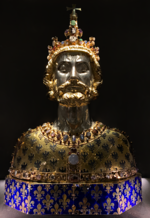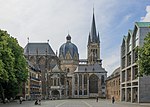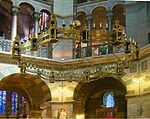Trams in Aachen

The Aachen tramway network (German: Straßenbahnnetz Aachen) was the backbone of public transport in Aachen, now in the federal state of North Rhine-Westphalia, Germany, and the surrounding areas from 1880 to 1974. The track gauge was 1,000 mm (3 ft 3+3⁄8 in), see Nordrhein-Westfalen. At times, the network also extended into Belgium and the Netherlands. At its maximum extent, its route length was 181.4 kilometres (112.7 mi) and its line length was 213.5 kilometres (132.7 mi). In 1914, it was the fourth largest tramway network in Germany. Also, it was one of the most extensive German interurban networks. In 1974, the last tramway in the network was closed. The network was operated from 1880 by the Aachener und Burtscheider Pferdeeisenbahn-Gesellschaft (in English: Aachen and Burtscheid Horse Railway Company), which in 1894 became the Aachener Kleinbahn-Gesellschaft (AKG, in English: Aachen Light Railway Company). In 1942 the name was changed to Aachener Straßenbahn und Energieversorgungs-AG (ASEAG, in English: Aachen Tramway and Power Company). It is now a bus company, but the company name still refers to trams.
Excerpt from the Wikipedia article Trams in Aachen (License: CC BY-SA 3.0, Authors, Images).Trams in Aachen
Ritter-Chorus-Straße, Aachen Burtscheid (Aachen-Mitte)
Geographical coordinates (GPS) Address Nearby Places Show on map
Geographical coordinates (GPS)
| Latitude | Longitude |
|---|---|
| N 50.775277777778 ° | E 6.0827777777778 ° |
Address
Ritter-Chorus-Straße 7
52062 Aachen, Burtscheid (Aachen-Mitte)
North Rhine-Westphalia, Germany
Open on Google Maps










